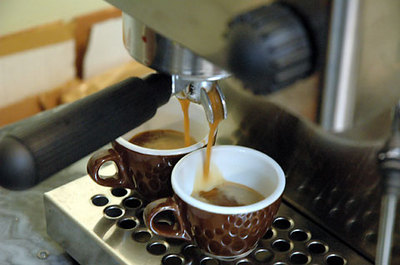 Tokyo’s turned hot and humid early this year (making up for last summer’s unseasonable coolness, I imagine) and I don’t want to cook. It’s time to dine on raw fruits and vegetables, icy drinks, and chilled soups.
Tokyo’s turned hot and humid early this year (making up for last summer’s unseasonable coolness, I imagine) and I don’t want to cook. It’s time to dine on raw fruits and vegetables, icy drinks, and chilled soups.
But fruits get boring, even when they are delectably ripe. Tod discovered a new way to enjoy them—dusted with freshly cracked black pepper. The sweetness of the fruit with the earthy tang of pepper is a surprising combination, but ever so wonderful.
Fruit with Black Pepper
Seasonal fruits: strawberries, sweet plums, peaches, etc
Whole black peppercorns
Pepper mill
Slice (or bite open) the fruit. Grind pepper generously on top. Enjoy.
Vary the recipe with pink, white, brown or green peppercorns. Each has its own flavor that enhances the fruit in delightful ways.
 When faced with a creative challenge—or even a mundane one— I devise a list of 10 ways to face the quandary. I end up with the usual, obvious answers and some off-the-wall notions, but there’s always one line in the list that will work.
When faced with a creative challenge—or even a mundane one— I devise a list of 10 ways to face the quandary. I end up with the usual, obvious answers and some off-the-wall notions, but there’s always one line in the list that will work.
There’s more than one way to skin a cat and making a list proves it.
For example, let’s say the task at hand is to photograph merchandise so that it can be sold on a website. We’re talking logo t-shirts, totebags and coffee mugs—dull, standard products—but the company is fun and creative and wants to bring that across in their online shop. What to do?
- Take standard studio product shots
- Photograph items in locations around the shop/office/city
- Photograph in a film noir style
- Show happy people using the products
- Create 360 degree views (Quicktime VR?)
- Show alternate uses (i.e. ferns in the coffee mug, t-shirt as towel)
- Combine product shots with manga-style mascots
- Use the products as screens over nude women ala “Calendar Girls”
- Don’t photograph at all—use drawings instead
- Photograph details but not the whole product
By the time I reach ten, I’m usually ready to add more, and often do. But starting out with a set goal of ten gets me past the usual ideas and into the realm of creative thoughts.
Try it, you’ll see what I mean.
13 August 1999
Tod was scheduled to arrive at Hiroshima at about quarter to one in the afternoon and I had no intention of running around to see things without him, so my morning was relaxed. I caught the 11:00 train to Hiroshima and arrived with plenty of time to scope out the coin lockers, load up on brochures at the tourist information desk and even to have a cup of coffee.
All my free time pointed out a delightful opportunity of good timing (finally!). While sipping my coffee and reading the tourist brochures, I discovered that Miyajima, a small island that was the destination for the next day, was holding its annual hanabi (fireworks) festival that night. So if we adjusted our itinerary we could see Miyajima’s today and visit the Hiroshima sights the next day. Which we did.
When Tod’s train came in, we went off for lunch. Hiroshima is known for two delicacies: oysters and okonomiyaki. Oysters are not my favorite food, so we opted for okonomiyaki for lunch.
Okonomiyaki is something like a pancake or a frittatta. We’d eaten them in Tokyo, but only at a fancy Ginza restaurant where the staff did the cooking. In the rest of Japan, okonomiyaki is a participatory experience.
We were seated at a table with a grill in the middle. Tod figured out the menu quickly and ordered two bowls of the basic “stuff” which included batter, eggs, cabbage and strips of pork, then added some extra toppings—garlic, rice paste balls, mushrooms. They arrived and I realized I had no idea what to do next! I looked at the waiter with a questioning look in my eyes and a little shrug, and mimed turning the bowl over onto the grill.
He was aghast. He kneeled at our table and explained the correct method for making okonomiyaki. Remove the pork strips and sit them on the smaller of the two paintscrapers that were out implements. Mix the remaining contents of the bowl and add the extra ingredients. After things were well mixed then the contents could be poured onto the grill. The larger spatula was used to shape the runny edges into a neat circle. When the pancake was golden brown on one side, the pork was laid on top and whole thing was flipped with the larger spatula to cook on side two.
He left us to cook but returned frequently to give us more water and watch our progress. He even corrected our mistakes. The result was delicious and the cooking was fun. Fully stuffed, we were ready to face our next challenge—an early check-in.
Our hotel was a traditional Japanese hotel with a good recommendation but a 4:00 check-in time. If we wanted to be on Miyajima in time to see the island and find a reasonably good place to sit among the crowd, we’d have to be there by late afternoon. So we headed across town to explain our predicament a few hours ahead of the check-in time.
They woman at the desk was understanding, took our bags, gave us advice on reaching Miyajima and even dug up some English language maps. But the price of our stay at the New Kikusui included a dinner we would not be able to eat and there was no refund. That was OK, though. We chalked it up to the price of changing plans at the last minute and went on our way to Miyajima.
The journey from the hotel involved a streetcar, a train and a ferry and took about 45 minutes. The ferry was filled with young women in yukata with their hair arranged in upsweeps and held in place with hair accessories ranging from traditional lacquer combs to Hello Kitty barrettes.
Two brightly blonde American girls, dressed in yukata and sitting with a group of Japanese girls similarly costumed and coifed, carried on a loud conversation about the immaturity of one of their American associates. I gathered that these two, and their absent companion, were exchange students or very young English teachers. Fortunately, they and their cortege vanished into the crowd as we disembarked and they scurried away towards the shops.
Because I had an agenda. It’s sort of a pain to have to see the sights when you visit somewhere. I planned to incorporate Miyajima into a story I would write for a magazine when I got back home, so I needed to check out and photograph as much as I could while I was there: the (inevitable?) ropeway to the top of Mt. Misen, the sacred forest and its wild monkeys; the view from the hill, the treasure house.
And of course, the most famous sight on Miyajima, Itsukushima Shrine is one of the Three Most Beautiful places in Japan. It sits on pilings at the water’s edge and at high tide it looks like it’s floating. The huge red torii gate sits further out in the sea and is an often photographed landmark—almost an icon of Japan.
Japan is full of “Three Most
Anyway, here we were at one of the Three Most Beautiful places in Japan and it was not living up to our expectations. First of all, the tide was out, so the shrine and its gate were not floating on water, but mired in mud. Then there were the deer. Very tame, miniature deer roam at will charmingly chewing on trash and tourists snap their photos. They are adorable, but the island at low tide has a distinct scent of deer urine.
But we were going to brave it all. Tod was feeling tired and had a headache from his trip. But there was a bus outside the ferry pier that Tod said would take us to the ropeway station halfway up the mountain. It would save us the fifteen minute uphill walk. We hopped on and a few minutes later found ourselves halfway around the island at a beach. Not the ropeway station. I tried to make the best of it and snapped a couple of photos to commemorate our error and we hopped on the return bus.
Tod’s headache was getting worse and the sun was just beginning to go down—we wouldn’t have enough time to reach the summit of the mountain, shoot photos and get back down in time to get a good vantage for the fireworks. So we abandoned everything but the fireworks and walked off in the direction of the shrine. The hanabi would be launched from barges in the water on the other side of the torii.
We walked through the makeshift festival arcade and scoped out the food options. Although still full from our late lunch, we knew that our stomachs would eventually start to grumble. When that time came, we passed up the traditional Japanese grilled whole skewered squid, the bits of octopus tucked inside a ball of batter and fried, the fried noodles. We went straight for the “familiar” foods—french fries and American Dog which you will recognize when it’s described as Corn Dog on a Stick. So much for going native…
Finding a suitable place to watch the fireworks was a challenge. The photographers’ tripods had the best views of all. The clustered between the shore and the torii facing the barges where the fireworks were waiting for dark. These photographers would get great shots of the gate silhouetted against the fire flowers in the sky.
Other photographers preferred a flanking view. No matter where we tried to stand or sit there was a photographer in front of us. I was wishing I had a tripod of my own. But I didn’t and the dozen or so photos I attempted that night look like fireworks in an earthquake!
The fireworks were incredibly beautiful. Japan knows how to do hanabi. All summer long you can see fireworks on the weekends and not the 20 minute Independence Day show at the park, but sixty to seventy five minute extravaganzas. Beautiful, huge loud displays. The Miyajima hanabi were especially beautiful and designed for those photographers. High circles of white and pale colored exploded above water level fountains of sparks. After a few minutes of action, the show paused for the smoke to clear and then began anew. Each set was more spectacular than the last.
Eventually it ended and we threaded our way back to the ferry. I bought a candy mekan—like a candy apple but a mandarin orange instead of an apple. A deer was stuck in the middle of the surging crowd. Confused and frightened, he was trying to back his way out of the crush of people but instead, backed into Tod! We reached the plaza outside the pier and stood in line with the thousands of other people who wanted to get back to Hiroshima. It took more than an hour to get on the ferry for our five minute ride across to the mainland.
Exhausted by the time we reached our hotel, we asked for our key and got into a conversation with the man at the desk who had lived in Tokyo for a number of years and knew our neighborhood. That was nice, but really I wanted to go shower (I hadn’t had one since 9 that morning!) and collapse into bed.
I was so tired that I couldn’t’ find the towels or the yukatas or the bars of soap that were neatly laid out on a lacquer tray and tucked into our closet (I found them in the morning). I showered with leftover soap I’d carried with me, used a washcloth to dry myself and fell into my futon. Tomorrow would be the last day on the road and I was looking forward to being finished with traveling.
14 August 1999
I was apprehensively cheerful when I woke. My next sleep would be in my own bed and I was looking forward to my own pillows and blankets—the first sign that I was ready to go home. But before I got to go home, I knew I was in for a difficult, emotional day.
Tod & I had discussed visiting Hiroshima many times. It’s an important place to visit. But we knew that it would depress us. I dreaded it. The horror of what happened during the war—and not just that war, that bomb, but all bombs, all wars—would affect me. Human stupidity at it’s very worst.
But the trip had to be made and when I planned the visit to Shikoku, it seemed logical to conclude it by meeting Tod in Hiroshima on the weekend. Get this out of the way, like a dentist’s appointment or a family reunion picnic.
Breakfast was a treat. We dined sitting on the floor of a beautiful lacquered and gilt dining room and the salted fish, rice, miso soup and pickles were so good that I momentarily regretted missing dinner the night before.
As we checked out, the woman behind the desk handed up each a little gift wrapped in a cone of tissue paper. They were tiny little mobiles made of peanuts painted to look like babies in swaddling. Odd but endearing. If we return to Hiroshima, I’m sure the New Kikusui will get our business again. And this time we’ll be sure to take all our meals.
We decided to stash our stuff in the coin lockers in the station which meant a detour but it wasn’t long before we alighted the street car at Genbaku Domu, the A-Bomb Dome.
Before the bomb, the building had been the Industrial Promotion Hall. After the bomb it was one of few structures left standing. You’ve seen pictures of it, I’m sure. Its domed top is a framework of curved iron; brick and stone walls are partially erect; empty windows give clear views through the ruin to the park on the other side. Huge chunks of carved stone look as if they were artfully arranged on the ground where they fell. It’s a powerful symbol. An icon.
And as an icon, I thought it would be dismissable. But it wasn’t. It was big and solid and not a photograph. It was real. Tod & I walked slowly around it and talked about it—what it looked like now. What had happened to it. I took some photographs but neither of us wanted to be photographed next to it. This was not the sort of place where we wanted to capture our visit.
The Peace Memorial Museum was on the other side of the park so we left the dome behind us. We hadn’t walked very far before I was attracted by a small crowd of people near a monument and the sound of a recorded announcement. We went over to have a closer look.
This was the Memorial Tower to Mobilized Students, we learned, as we stood back and listened to the English announcement. During the war, Japanese children over the age of 12 we drafted to work for the war effort. They held factory jobs, or farmed or ripped down buildings to create firebreaks. And when the bomb dropped, many thousands of them in Hiroshima died. Difficult to imagine, isn’t it? But thinking about it made my eyes fill with tears. So unjust.
The Peace Park is filled with monuments, both major and minor, to memorialize war victims in groups or individually, to recognize the suffering of the bomb’s survivors, to promote peace, to serve as reminders of what happened. By the time we reached the museum at the other end of the park, we’d passed by dozens. There were too many to look at but we paused in front of the main ones: the flame of peace which will burn until all nuclear weapons are disarmed; the arched cenotaph through which you can see the flame and the dome; and the children’s peace memorial with its legion of origami cranes arranged in neat rows and huge piles at its base.
A legend that says if you fold a thousand paper cranes, your wish will come true. Ten years after the war, a girl named Sadako had contracted radiation-induced leukemia. She folded paper cranes in the hope that if she got to 1000 she would be cured but she did died before reaching her goal. Today the cranes symbolize peace and are seen all over Hiroshima. People fold them and send them from around the world to be placed near the monuments. They are brightly colored and add a strange air of festivity to the somber reminders of the past—like party decorations at a funeral.
Guidebooks recommended a half hour to an hour at the Peace Memorial Museum. Tod & I were there for four hours and could easily have been there for longer. After paying our 50 yen admission (about 40 cents), we were pointed toward the special exhibits in the basement.
A week previously, at Aono-san’s parents’ house I had watched the annual Hiroshima memorial ceremonies on TV as we ate breakfast. The mayor of Hiroshima gave a speech and two middle school children, dressed in their school uniforms mounted the steps of the podium in lockstep and delivered a speech in unison. The speeches, which I understood little of when broadcast on TV, were on display in the exhibit room. I read the translations and they were powerful cries for Peace on Earth.
The mayor had solicited letters from foreign ambassadors in Japan and they, too were on display. It was fascinating to read them and discover the range of views on atomic weaponry and world peace. Of particular interest were those from India and Pakistan, displayed at opposite ends of the room as if they would somehow cause damage if near one another. In these letters, each ambassador blamed his neighbor for starting the arms race that the countries are now in. I noted that the American ambassador had not replied to the mayor.
We were fortunate to be in town at the same time as a collection of printed materials on loan from the University of Maryland. It was a fascinating and disturbing illustration of censorship in Occupied Japan. I learned much about the power of media control and invisible censoring that morning. There were so many things the Japanese were not allowed to write about—the bomb, it’s aftereffects, food shortages, the Emperor, disparaging or even questionable comments about the occupying forces, the command structure of the occupational government and of course, censorship was not allowed to be mentioned whatsoever.
I wondered if all this was the right thing? The censoring department helped promote stability, I suppose. It absolutely shaped Japan into what it is today. I doubt the average American of my generation really understands what an influence America was on Japan in the early 1950s. From politics to fashion; Japan was inundated and never had a chance to escape it.
My brain was reeling and we weren’t even out of the basement yet. A gallery of paintings and drawings done by A-bomb survivors and one that talked about the impact of the war on children—from the bomb to the years of occupation and beyond—filled the rest of the halls downstairs. We learned about the how orphaned children survived; how schools were back in session by October, how rationing during and immediately after the war stunted children’s growth.
The museum, on alternate Wednesdays (which our visit was not), mixed up a batch of the powdered milk which was the entirety of children’s school lunches in the time immediately following the bomb. “Come and try the nostalgic taste of powdered milk so many children drank at school” a sign read.
Two hours in the basement and it was time for a break. In the tiny cafeteria on the first floor, I had a bar of red bean ice cream and Tod had a cheeseburger from a vending machine that conveyed the refrigerated burger through a microwave and dispensed it steaming hot for your eating pleasure. Tod said it wasn’t bad. I mused over the irony that the technology which made Tod’s hot snack possible in the peace museum had probably originally been developed for the military.
Finally we were ready to tour the permanent exhibits. It was crowded and dimly illuminated on the first floor. Two large dioramas took center stage. One showed Hiroshima before and one after the bomb. An old man talked over his wartime experiences with a green-jacketed docent and some teenage visitors. He pointed to places in the diorama and talked in a croaky voice while people gathered around him and nodded solemnly.
The museum had a message to convey—No more Hiroshimas—and it did its job well though was sometimes a bit heavy handed with descriptives.
They told the story of Hiroshima before the war, during the instant of the bomb and for the years after the war with photographs, maps, simple explanations of the technology of nuclear weaponry, political aspects to nuclear disarmament. Why Hiroshima was the target and why drop a bomb at all were briefly explained.
What I found most disturbing were the “material witnesses.” Scraps of clothing, watches stopped at 8:15, charred lunch boxes, half melted belt buckles and other personal belongings were accompanied by short biographies of their owners and the date and time of their death along with, in some cases, how far from the hypocenter the item was found. Some of the stories were tragic.
In too many cases, people survived the initial blast but were grievously wounded and died within a day or two after making heroic treks home from the city. One teenage boy who had been working in the city was burned over a huge portion of his body but managed to walk kilometers to reach home. His skin was peeling in strips from this wounds and his fingernails fell off. When he died later that day, his mother kept the nails and bits of flesh to show his father who was in the army and not at home. Now we all get to see the gruesome reminders.
It was difficult to read all these, but at one point, after seeing the twentieth or thirtieth uniform blouse of a teenage girl or charred work pants of an old man, I thought I was getting numbed to it. The individual stories were blurring together and I was relieved to see that I was nearing the end of the exhibit. Then I came to the tricycle.
The battered red tricycle was owned by a three year old boy who rode it every day and loved it the way little kids love their favorite toys. When the bomb went off, he was riding outside. He was killed instantly and the tricycle was mangled. His father buried them together in the back yard so that his son would have his best friend nearby and would not be lonely. That got me. Tears slipped down my cheeks and I hurried away to find Tod who had gotten ahead of me.
Fortunately there wasn’t much more of the museum to cover and we dispatched the melted bottles and roof tiles quickly and with a minimum of emotion. The shadow of someone sitting on the granite stairs of a bank wasn’t nearly as powerful as I thought it would be. It looked like a blotch of dirt and not a human shadow.
Regardless, it was a draining experience and we both felt limp and exhausted when we left. It was 2:30 and we were hungry. We had three hours before the train was scheduled to leave so we wandered around the town. We could have visited the castle or one of the art museums or any number of non-atomic sights but lunch and a fruitless search for English books occupied us instead.
I’d like to return to Hiroshima. Despite the parts I’ve described, it’s not a solemn place overall. It’s a typical Japanese city with big, ugly ferro-concrete buildings, museums bursting with artworks, a baseball team called the Carp, a zoo, many gardens and even a manga library. Now that I’ve toured the grim but important part of Hiroshima, I would like to experience the rest of it.
Maybe someday. But for now I need a rest.
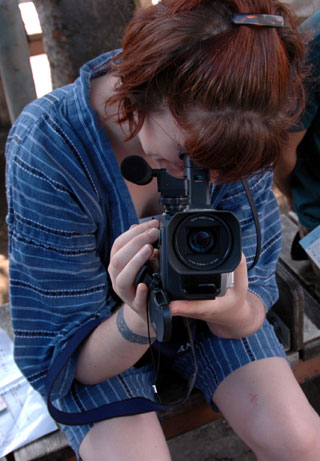
Yesterday we reprised last year’s Tanabata matsuri festivities with MJ & Yoshi. I brought my DV camera; Tod carried his new D-70 digital camera. Dressed in men’s indigo jinbei (traditional loose jackets with shorts), we captured the festival thoroughly and probably turned a few heads—henna gaijin (weird foreigners) wearing Japanese clothes.
I hoped to make a short film about Altair and Vega, the stars of the matsuri, but Tod declined to be my leading man. Still, I shot a lot of footage and you’ll see a brief documentary, “Scenes from Shonan Hiratsuka Tanabata,” on Wednesday the 7th, the actual date of Tanabata.
Summer heat and humidity was making my mop too frizzy to handle, so I cut my hair. I did it myself at home, see:
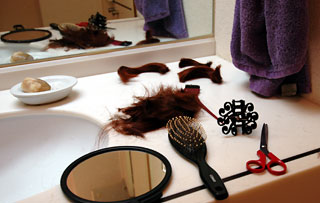
(Anyone want a lock of mediatinker hair?)
The initial cut was a bit nerve-wracking, just like making the first sketch in a new notebook or writing the first page of a story. But after I sliced off a 10 cm chunk, I was committed and could relax and have fun with it. Twist, snip, twist, snip, twist snip. I hardly even looked at what I was doing. Tod calls it the “Molly goes mad with scissors” cut. It does look a bit like a three year old had at me while I was napping.

Can’t decide about the single long strand. I like the asymmetry, but it sort of gets in my way. Should fashion (such as it is) come first or should function reign? What do you think? Your opinions are welcome…but please be gentle.
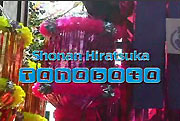
![]() Shonan Hiratsuka Tanabata festival 2’20” (14.1 MB MP4)
Shonan Hiratsuka Tanabata festival 2’20” (14.1 MB MP4)
Altair and Vega get together in the Milky Way and I catch it all on video. OK, maybe not, but I did document the matsuri in Kanagawa.
 Inspired by a recipe for cucumber and peach salsa and my recent trend towards fruit with pepper, I added a Japanese flair and served this salad at a dinner party last week with Eric Gower, author of the Breakaway Japanese Kitchen.
Inspired by a recipe for cucumber and peach salsa and my recent trend towards fruit with pepper, I added a Japanese flair and served this salad at a dinner party last week with Eric Gower, author of the Breakaway Japanese Kitchen.
Cucumber and Peach Salad
Makes about 6 cups
4 Japanese cucumbers
3 peaches
1/4 cup pistachios
3 leaves shiso
1/2 bulb myoga
1 or 2 limes, juiced
1/2 tsp yuzu vinegar
salt and pepper to taste
Peel and chop the cucumbers and peaches into bite-sized pieces. Mince the shiso and myoga, whisk together with lime juice and yuzu vinegar. Pour over salad. Toss in the nuts. Season with salt and plenty of freshly crushed black pepper.
Note: if using American cucumbers, two should be enough. You may want to de-seed them, though.
 Today’s creative solution to heat-induced stupor and writer’s block in the form of a transcript of a conversation on iChat
Today’s creative solution to heat-induced stupor and writer’s block in the form of a transcript of a conversation on iChat
Kristen: I need to write my Creative Perspectives column
Kristen: I’ve started it four or five times
Kristen: but I can’t get my head wrapped around anything
MJ: hmmm
MJ: what’s the focus today?
Kristen: well, it might have been scent, or rearranging space, or a couple of other things
Kristen: but when I started writing, the words failed to come to me
Kristen: and I gave up on all of them
MJ: hmmmm
MJ: how about writing about fighting writer’s block?
Kristen: hehehe. I’m sure that wouldn’t go anywhere either
Kristen: but maybe I can try.
MJ: well let’s see what to do when you have writer’s block….
MJ: you can:
MJ: try a different scene (go for a walk, go to a cafe)
MJ: start working on something else and let your subconscious mind tackle it for a while
MJ: what do you usually do?
Kristen: I walk away and come back to it later
Kristen: Or I get you to write my column for me. :-)
Thanks, MJ
Tod recently bought a new camera—the awesome Nikon D-70 digital SLR. He’s been having a field day photographing everything. I particularly liked this shot of coffee he snapped the other morning:
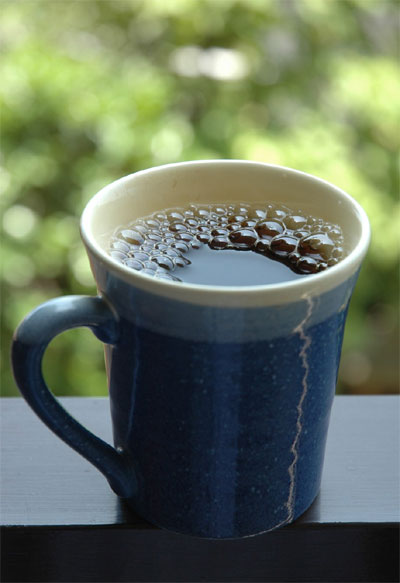
And keeping with the coffee theme, I took these pictures at a friend’s house:
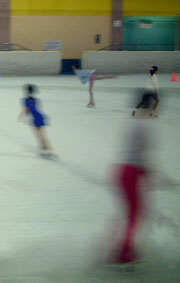 Jingu Skate Rink is an oasis in summer.
Jingu Skate Rink is an oasis in summer.
If you overlook the slightly choppy ice surface, unsharpened rental skates, and a few crazies on the ice, this is the best place to spend a 34 degree afternoon that I can think of. It’s cool. It’s athletic. And it’s not too crowded on a Saturday.
We went yesterday. Tod hadn’t skated in about ten years, but within minutes he was skating backwards and zipping around the rink. I can only skate forwards, a little shakily, but I loosened up after a couple of laps. Even with a wobble, I love to skate.
I turned around the rink with Lionel Belasco tunes running through my head, and the first few lines from Neal Stephenson’s The Diamond Age
“The bells of St. Mark’s were ringing changes up on the mountain when Bud skated over to the mod parlor to upgrade his skull gun. Bud had a nice new pair of blades with a top speed of anywhere from a hundred to a hundred and fifty kilometers, depending on how fat you were and whether or not you wore aero.”
Later on, Stephenson describes Bud as “a little hinky on those skates” which is exactly how I see myself. Only I don’t have the skull gun.
Info on the skating ring (in Japanese): http://www.meijijingu.or.jp/gaien/05.htm
Language is full of words that people rarely use. The average English speaker’s vocabulary is about 10,000 words from the 620,000 available in the OED. Shakespeare used 29,066 different words in his works and you have to imagine that he knew quite a few he didn’t commit to paper.
Although I have no clue how large my lexicon is, I take pleasure in knowing odd words. Authors with large vocabularies, correctly used, make me smile, especially when our word-banks overlap.
This morning as I was reading Neal Stephenson’s The Confusion, I came across a word that I love but have never, ever seen in context.
“The Armenian boy whispered up on slippered feet, bearing on a gaudy silver salver a tiny beaker of coffee clenched in a writhen silver zarf.”
Zarf, along with vug, is a gift from my grandfather and his sister, Louise, who were both avid Scrabble players. My sister has the unabridged dictionary they used as their arbiter, but I received the pleasure of reading a word I’d only known as a curiosity from their games.
What a great way to begin a week.
In the last two weeks, cockroaches seem to have taken up residence in our bathroom. On alternate evenings, I spy a reddish-brown monster the size of my thumb hanging out near the sink or in the shower.
Gokiburi are not my my list of Things I Can Kill, so we chase them around the room, trap them in a glass and fling them over the veranda into the garden below.
I’m sure the neighbors love us.
Why do people (I mean citizens of industrialised nations) insist on prolonged life? So many people seek medical intervention when they get old, or their unhealthy lives catch up with them, or a genetic predisposition to ailments becomes clear. But why?
This excerpt from a Reuters article today is what set my blood boiling:
New U.S. cholesterol guidelines issued on Monday set the lowest level yet for high-risk patients, with recommendations for aggressive use of drugs to get levels down.
The new recommendations also stress no patient should rely on drugs alone to lower cholesterol, but should also take responsibility for the right diet and exercise to keep the heart and arteries healthy.
Living things get old, fall ill, and die: that’s Nature’s cycle. It makes me furious that people like us try to cheat death with “aggressive use of drugs” and medical procedures. Doesn’t “should also take responsibility” sound as if being responsible for your actions is secondary to getting the right medication?
Cripes! Make your choices and live (or die) with them.
I grant that some folks are late bloomers and that numerous key figures in history were bolstered by medical arts. But if they hadn’t survived, we’d be familiar with some other character’s paintings or polemics.
Reasons to accept medical intervention strike closer to home, too. My own father has recently undergone multiple heart surgeries to clear blocked arteries. Both my parents take medication daily to maintain their health.
But neither history nor family changes my mind. I think it’s wrong to meddle with the decay of the body.
I advocate an aggressive sense of mortality.
Two articles today about mad cow testing. First from the US (via Reuters)
A government investigation on Tuesday gave the U.S. Department of Agriculture poor marks in testing cattle for mad cow disease, saying the agency was neglecting to test the majority of cattle most at risk.
“The problems identified during our review, if not corrected, may … reduce the credibility of any assertion regarding the prevalence of BSE (bovine spongiform encephalopathy) in the United States,” said the USDA’s Office of Inspector General.
And now this news from Japan (via UPI):
A top Japanese official said Tuesday blanket mad cow testing may end soon, a move widely seen as opening the door to resumption of U.S. beef imports.
Hiroyuki Hosoda, chief cabinet secretary, made the comment ahead of beef talks to be held in Tokyo in late July between experts and government officials from Japan and the United States, the Kyodo news agency said.
The question of whether all slaughtered cattle should be tested for mad cow disease should not be dealt with “politically,” Hosoda said, indicating Japan may end its blanket testing if experts find it unnecessary.
Tokyo has blocked U.S. beef imports since the first U.S. case of mad cow disease was found in a Canadian-born cow in the state of Washington last December.
To remove the import ban, Tokyo has been asking the U.S. government to test all slaughtered cattle for the disease or provide equivalent safety assurance.
U.S. officials respond that blanket testing is unscientific.
Right hand, may I introduce Mr. Left Hand?
 It’s too hot to eat, but not too hot for fruity drinks. I invented this one last night. The garam masala adds a subtle spice and the Cointreau sweetens the bite of the yogurt.
It’s too hot to eat, but not too hot for fruity drinks. I invented this one last night. The garam masala adds a subtle spice and the Cointreau sweetens the bite of the yogurt.
Banana-Cointreau Lassi
Makes 2 generous servings
2 or 3 cups ice
2 bananas, peeled
1 cup plain yogurt
1/4 tsp garam masala powder
2 oz Cointreau
Put it all in a powerful blender. Blend until smooth. Serve over ice.
 Last night I went to a festival with two photographers. I didn’t have a camera, so I spent my night watching them taking pictures.
Last night I went to a festival with two photographers. I didn’t have a camera, so I spent my night watching them taking pictures.
“Oh, this is going to be dreadfully dull,” I thought. I knew I’d be frustrated as I saw things to photograph but didn’t have an instrument to do it.
As it turned out, it was an engaging evening and I had plenty to occupy me. I studied their techniques and choice of subjects. I started to guess how each would approach the lanterns, the dancers, the food stalls, the lights. They rarely took the same shots. I compared theirs to what I would do with camera in hand.
I was an active spectator. I paid attention to what was going on around me and my assiduity paid back new perspectives on seeing the world through a lens.
Every once in a while Japan Today’s RSS feed includes an internal memo. This one appeared this morning under “National Headlines”
MESSAGE TO JANE
Hi Jane, I moderated until 12:00am (0:00) on the message boards. There are some not so nice things going on so be careful on the people who are posting especially on Jenkins and the gay marrige issues. After you are done moderating for the day,…
Oops. I’ve also noticed partly-edited articles in their feed that turn up fully edited under a different headline later.
This glimpse inside the inner workings of JT isn’t too compromising. But imagine a major news agency or corporation feeding something before it was ready: scoops, scandals, and all sorts of informational mayhem.
Any bets on when and where it will happen first?
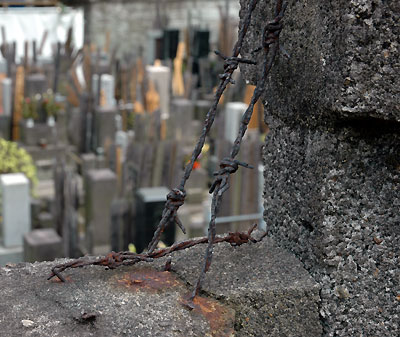
Cemetery wall, Bunkyo-ku
Does the barbed wire keep the ghosts in or the graverobbers out?
Originally published in Epicure Exchange in 1997; photos taken on July 17, 2004
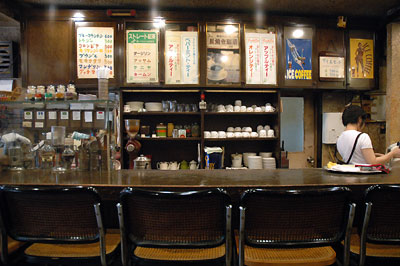
Unlike the dying breed of classic American coffee shops of the 1950s, the traditional coffee shop in Tokyo still thrives. These family owned coffeehouses, called kissaten (kee-sah-ten), have been around since WWII. Although most of them seem to have undergone a redecoration phase in the late sixties or early seventies, they haven’t changed much since the forties.
Walk into a kissaten on a hot summer day and you are greeted with a cheery “Irasshaimase!” from the owner’s wife, who tends the cash register and serves the coffee. Her liveliness is in contrast with her surroundings, which are dark and dank. An almost overpowering smell of mildew— the residue from years of rainy season and hot, humid summers—wafts through the room as the door closes.
The interior is dimly lit and while each shop owner decorates to his (or his wife’s) taste, dark wood and earth tones seem to predominate at most places. In this kissaten, the tables have grey marble tops, the heavy, wooden chairs have been upholstered in red velvet and the yellowing walls are strewn with clocks and landscape paintings of Europe. Lamps with hand blown globes hang at regular intervals down the corridor of tables that leads to the coffee bar.
This is not Starbucks. The coffee bar is made of wood, not laminate. It is standing height and the man who stands behind it tending the pots and grinders could never be called a barista. There is not an espresso machine in sight.
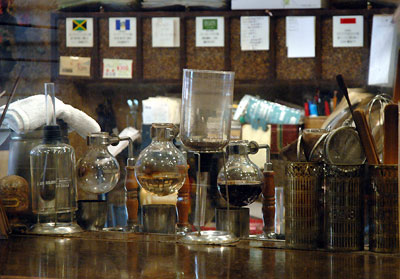
The tools of the trade look like equipment in an antique science laboratory. Arranged along the bar are a handful of gas outlets. Over each one sits a giant test tube holder with a glass bowl half full of coffee in its grip. A gas burner that would look at home in a kitchen keeps a kettle of water boiling. On a shelf behind the bar sits a group of brewing pots—a combination of glass receptacles and plastic filter baskets.
When an order is placed, the coffee man goes into action. He is fluid and artistic as he measures out and grinds an individual serving of coffee, simultaneously reaching for the brewing pot. Gently depositing the grounds into the filter basket, he carefully pours hot water into the apparatus, swirling the pot a bit to encourage the brewing, adding more water, watching until the coffee is just right. Then, selecting a cup and saucer from the mismatched collection that time has created, he removes the filter basket and pours the coffee into the cup.
His wife delivers the coffee along with a wood-topped glass container of sugar and a tiny pitcher of cream. For the price of 500 yen (about $5 US) you receive a cup of kohi (coffee), countless glasses of mizu (water) and a place to sit for as long as you like.
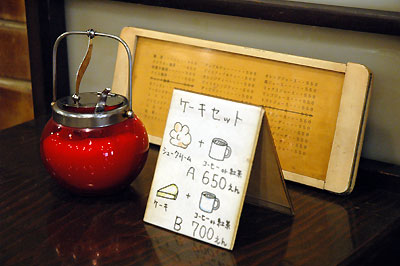
The emphasis in these coffeehouses is on “house” and not on coffee. The high price of coffee is as much a rental fee as it is beverage. Citizens of this crowded metropolis live in cramped quarters so alternate places to relax or work are essential. To find a kissaten that fits your mood and style is to find a second home; most kissaten boast a bevy of regular customers. Neighborhood wives take a break from daily chores and meet their friends for cafe au lait and gossip. Businessmen take refuge from the stresses of the office with a newspaper and coffee or come to vent midday frustrations with their coworkers.
The atmosphere of cool, damp, darkness keeps conversations quiet. Thoughts do not have to compete with blaring rock music and chattering schoolgirls, making the kissaten a good place to plan and work. For those in a solitary but uncontemplative mood, a shared library of used magazines and comics entertains.
When the coffee in the cup is gone, work complete, conversations finished, it is time to leave the cavern of coffee. Walking out into the hot sunshine is a pleasant shock. Across the street is an outlet of one of the coffeehouse chains. The coffee there is cheap and consistent, but the atmosphere is sterile and full of giggling girls and frantic commuters looking for a quick caffeine fix. How unenlightened.
My mother and mother-in-law are coming (together) to visit for two weeks this autumn. My mother’s never visited Japan. Jean, Tod’s mom, has been here once before.
I’ve been thinking of things to make their trip special. I’m sharing my list here, because if I don’t I’ll forget everything (and there’s no Google search on “what to do with your mother in Tokyo”), but also I’d like to hear what you’ve done with your folks when they’ve been to visit.
(And yes, Mom & Jean, you’re welcome to suggest anything you like!)
- Onsen ryokan - Kishigon at Ikaho or Araki Kosen Onsen in Chichibu
- Taste of Culture class
- Takarazuka Review show
- Party to show off friends to mothers (or vice versa)
- Dinner at Goenmon (tofu in Hakusan) and Hantei (kushiage in Nezu)
- Hakone day trip or overnight (should be good momiji season)
- Asakusa - river taxi - Hamaryuku - Ginza
- Lots of grocery shopping and cooking at home
- Plenty of just hanging out doing nothing days, too.
It’s bloody hot here. Yesterday the weather service recorded Tokyo’s highest temperature since they began measurements in 1923—it was 39.5 (just over 103 F) in Otemachi. 210 people were treated for heatstroke, but I don’t think anyone died.
Being outside was like walking through blood.
Today was slightly cooler at 37.2 (99 F) but I had to dress up for the CEATEC poster photo shoot, so I was wearing cosmetics, pantyhose, and a suit. Atsuiiiiii!
The average temperature in Tokyo for 7/21 is 25.8 but today’s average is 33.3. I can only hope that this ends very soon or I am going to melt.
 Tokyo’s heat wave got me thinking about ices and I’ve mixed up a lot of granitas this week. They’re simple to prepare and taste delicious.
Tokyo’s heat wave got me thinking about ices and I’ve mixed up a lot of granitas this week. They’re simple to prepare and taste delicious.
Viennese Coffee Granita
serves 4
2 cups coffee
1/4 tsp cinnamon
1 cup milk
1/2 cup sugar
1/2 tsp vanilla
Mix the coffee, cinnamon and 3 tablespoons of sugar. Pour into a shallow pan and freeze. Once an hour until it freezes, use a fork to stir and scrape the ice, breaking up the lumps.
In a separate pan, mix the milk, vanilla and remaining sugar. Freeze, scraping hourly as above. The milk will take a little longer to freeze than the coffee.
Serve the coffee granita topped with the sweet milky granita.
Blueberry-Ginger Granita
serves 4
2 cups blueberries
1/2 tsp grated ginger
1/2 cup sugar
1/2 cup water
1/2 lime, juiced
Whirl the blueberries, ginger and sugar in a blender. Strain the solids from the liquid, using a fine sieve. To the liquid, add the water and lime juice. Pour into a shallow pan and freeze. Once an hour until it freezes, use a fork to stir and scrape the ice, breaking up the lumps.
Shiso Lemon Granita
serves 4
8 leaves shiso
2 cups water
1/4 cup sugar
1 lemon, juiced
Roughly chop the shiso leaves, then whirls in a blender with the water and sugar. Strain the solids from the liquid with a fine sieve. add the lemon juice. Pour into a shallow pan and freeze. Once an hour until it freezes, use a fork to stir and scrape the ice, breaking up the lumps.
 A newcomer to Tokyo was going on about the expense of keeping entertained in the city. When I countered that there are lots of low-cost and no-cost things to do, he challenged me to list them.
A newcomer to Tokyo was going on about the expense of keeping entertained in the city. When I countered that there are lots of low-cost and no-cost things to do, he challenged me to list them.
And I did, but what struck me is that most of the things I do to amuse myself are creative. If I have a camera with me, or a sketchbook, video camera, or notebook, I spend my time observing and recording things around me. If I don’t have a device to record, I simply watch.
(Or I run into a shop to buy a notebook and pan—I’m the owner of countless notebooks and pens purchased because of an urgent need to write in the field.)
So while my tools may cost me a bit of cash, I occupy my time using them at very little cost. If I’m lucky, they sometimes make me money, too. Being a creative person has hidden fiscal advantages.
When I put on my bathing suit, I look like a lumpy breakfast link.
Common wisdom has it that you lose weight during the summer. Maybe because you get outside and exercise more, eat lots of fresh veggies, sweat it all away, or something. Whatever it is, shedding pounds is a summertime occupation according to every women’s magazine and most of my friends.
But it’s a lie! I gain weight in the summer. Maybe that’s because I try to stay cool with increased intake of alcohol and frozen sugary things (in combination whenever possible). I eat out because it’s too hot to cook.
Worst of all, I don’t go out for long walks or exert myself too much.
I turn an alarming, vivid pink if I do much more than breathe on a hot day. Childhood neighbors used to drag me out of the playgroup and feed me lemonade and cookies in their air-conditioned kitchens because they thought I’d have heatstroke. It’s a peaches-and-cream complexion, blotchy British-heritage thing. Ugly but unavoidable.
So from long-standing habit and to prevent alarm, my athleticism is limited to swimming a couple of times a week. I’m not going for any extended rambles through the city until the weather cools off some.
Maybe I should brave the heat, sweat off the weight, ignore my beetroot face, and stay away from rum-infused frozen drinks, but then what would I blog about when it’s too hot to think?
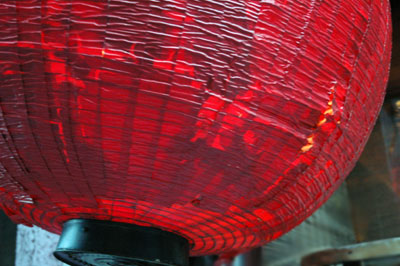
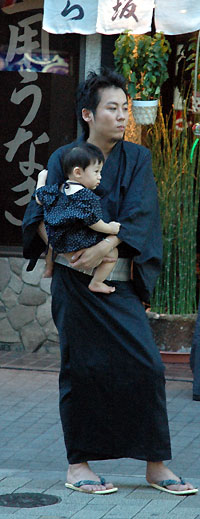 Kagurazaka is one of Tokyo’s well known “traditional” neighborhoods. Despite encroaching fast food chains and convenience stores, it’s still an authentic working neighborhood, not at all staged or quaint. Kagurazaka charms by its utter lack of pretense.
Kagurazaka is one of Tokyo’s well known “traditional” neighborhoods. Despite encroaching fast food chains and convenience stores, it’s still an authentic working neighborhood, not at all staged or quaint. Kagurazaka charms by its utter lack of pretense.
The sloping street leading from the station to the temple is lined with family owned shops and restaurants. The side streets teem with tiny bars displaying red lanterns for signs. Shop owners come out in the afternoon wet down the street and cool things off. Cats roam the alleys.
Many lively precincts like Kagurazaka are fading memories. There was a similar neighborhood feel in Koishikawa, on the other side of the river in Bunkyo-ku, but it has been wiped out by developers who snatched up the old 2-story storefronts and constructed towering luxury condo highrises. Where there used to be three streets of shotengai, now there are 7 or 8 giant apartment blocks. Ironically, they use the neighborhood’s former charm as a selling point.
But Kagurazaka holds out for now. Walking through yesterday, we stumbled upon the annual matsuri and watched the awaodori dancers milling around before their performances and all of the spectators dressed in yukata. Although most of the people wearing yukata were women (young or old, but not too many in the middle years), a few men dressed for the occasion, too. A double dose of tradition to tide us over for a while.
I want a typewriter. I want to unplug from the digital world for a while and reconnect with the physical.
As a kid, I used my grandfather’s portable manual typewriter to produce newspapers, menus, play programs, and all the other essential printed matter of my fantasies.
One of my first purchases as a working teenager was an electric typewriter. I typed out every issue of the West Hazleton High School “We-Ha” during my tenure as editor, then I carried it with me to university and used it for all my papers. And a few play programs.
But those old machines are both gone, as is the early 20th century Royal I found at a flea market. Now it’s just me and the computers.
And I’m dissatisfied. I’d like to write without being distracted by incoming e-mail, IM, and RSS feed updates. You’re thinking, “Well, don’t launch those programs when you write.” But I get antsy wondering might be missing some key communication. Does someone want to go to lunch with me? Have any of my friends updated their weblogs? Critical information—who’d want to miss that?
I’d like to return to fact-checking by referring to books instead of Google. My capacity to store facts and trivia was once legend, but has dwindled to nearly nothing. My brain is full of key-combinations to effect changes in my documents, but I can’t remember the population of Tokyo or recall when I should use ‘effect’ or ‘affect.’
Ironically, I’ve just purchased a new G5 with an amazingly large screen so that I can do my video editing in double-quick time. It arrives in 5 weeks. I’m doomed.
Sorry this is not terribly interesting and sounds sort of whinging. Today is Day 4 of a fairly bad migraine. I’m not looking for sympathy or help, just noting the progress of the symptoms for my own future reference.
Day 1: Notice some blinking white spots in front of my eyes but they are not my usual visual disturbances. Feeling a little tired, assume it’s the hot weather. Don’t really twig that this could be a migraine.
Day 2: Nauseated. Pupils are unevenly dilated. Flat surfaces seem to buckle and melt. The left side of my head feels bigger than the right side and I can’t speak straight—the words come out in the wrong order. No bad pain, so I get on with the day, go to the beach, have a bbq with friends. No alcohol since I know that will make it worse.
Day 3: Sharp pains begin stabbing my head in the morning. Try to nap, but they keep waking me up. Spend the entire day in bed, reading. In the late afternoon, I discover I am slightly feverish. Fall asleep by 10:15.
Day 4: Wake to occasional stabs and cold explosions in my head. Some nausea, but tolerable. My entire left side feels dulled and swollen (of course it’s not any bigger than normal) Everything is too loud and bright. Still feverish. Pupils uneven again. Eyes hurt. Shiatsu took away some of the dullness, but none of the pain.
I am annoyed with how long this is going on. I have things to do but no energy to do them. C’mon body, behave.
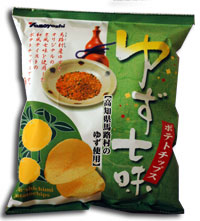 Here’s a product you’re not likely to find in American grocery stores. These potato chips are yuzu-shichimi flavoured.
Here’s a product you’re not likely to find in American grocery stores. These potato chips are yuzu-shichimi flavoured.
I’m a bit of a traditionalist when it comes to fried potato snacks—salt is sufficient seasoning—but these are pretty good for doctored chips. The yuzu is subtle; the shichimi is barely there. If you want a blast of overpoweringly spicy citrus flavour, these are not the snack for you. But if you are looking for something gently different, then I recommend them.
Yamayoshi also makes the popular WasaBeef (wasabi beef) chips and a host of others. They have a website with dancing bobble-headed cows in their TV commercials and online shopping, but they don’t ship outside Japan.
Another two-man video crew in town, so another odd job for Mediatinker. This time I’m logging LA interview tapes and rounding up Japanese women for interviews about personal style, “transculturalism” and shoes.
Thanks to all my J-girlfriends and their friends who’ve responded. I hope you have fun.
Oh, and a tip for your interview: pause before answering the questions. The person who logs the tapes will love you for that.
 Marshmallow Spike played in Yotsuya last night—their first show inside the Yamanote. Tod took lots of photos.
Marshmallow Spike played in Yotsuya last night—their first show inside the Yamanote. Tod took lots of photos.
They get better and better every time I see them. MJ even smiled last night while she played and her MC patter had the audience cracking up. Sweaty men on trains, indeed…
And they know who the fans are: Yoshi dedicated “Stolen Umbrella” (download the MP3) to me last night with a quick “for Kristen” before playing the first chords, and he gave me his backstage pass after the show. (Am I almost famous now?) MJ’s pass went to Tracey, who also got her CD signed. We’re such groupies.
The next show is in Yokohama on August 11th. See you there?
I am not sure how I spaced out so badly, but Thursday and Friday both passed without the vaguest flitter in my mind that I had columns to write. So for those of you anxious about Recipe Thursday and Creative Perspectives, never fear. They will be back on schedule next week.
And in the meantime, I’m going to post twice today because I realise that nowhere in the weblog do I have a bio or summary of the author. Who am I, anyway? So I’ll be writing up a little Q&A style “about mediatinker” thing today. Check back later—and feel free to suggest some questions. I’ll do with the answers without the aid of my peanut gallery (and yes, UltraBob, I do mean you. ;-)
Q & A
Who are you?
I’m a kindergartner who was excited to learn that she’d be a grown up in the new millennium.
Why do you live in Japan?
It was a six-month job assignment back in 1998. Japan suits me so well that I haven’t left yet and don’t intend to.
Why do you have a weblog?
I use my weblog to entertain (and sometimes enlighten) friends and strangers. It also anchors me to my computer. I started out with a regular website (1994) and a mailing list (1998). When weblog software reached my radar in 2000, I converted.
You come across as such a know-it-all sometimes…
I used to be a know-it-all but now Google knows more than I do. Fortunately, I’m only one search away from knowing it all again. Don’t ask me for facts when I’m not at my computer.
What do you do?
I make videos. I write stuff. I do web things from time to time. I’m for hire, so please take a look at my resume and portfolio, then contact me if you’re interested.
What else do you do?
When I drag myself away from the virtual world, I am usually swimming, cooking, taking long walks, scratching in notebooks, or reading. I also run around doing stupid things with my very smart friends.
What do you like?
Vanilla. Strong coffee. Black. Good words. Water. The sound of wind through pines. The night sky. And Tod—I like him very much.
Can you recommend what to see in Tokyo?
Yes, I can. Check out the Hello Tokyo page. Buy a copy of my DVD. Please.
Can I send you an e-mail?
Of course, but no guarantee of a reply. kristen@mediatinker.com
About Mediatinker
It’s been more than ten years since I helped to found Telerama, one of the first public ISPs in the US. I answered phones, offered tech support, wrote documentation, taught online classes (using IRC and Screen!) and was general dogsbody to the tech boys. Good times with lots to learn—in those days, the Net was new to almost everyone. But being excluded from the hard-core tech back then, I’ve never considered myself much of a geek.
In the mid-nineties, I was working for a university, teaching faculty and administrators how to use e-mail, ftp and telnet with lots of time devoted to writing how-to manuals and tip sheets. Eventually, I became university webmaster and launched into developing online instructional materials, video, audio and interactive tutorials.
A three month trip to Japan in 1996 ushered in a new era of international living. In 1998 we moved to Singapore for six months, followed by a move to Tokyo and a short term assignment as Year 2000 Test Center Manager for Perot Systems Japan/UBS Warburg. Going on seven years later, we’re still here.
These days, I sit at my desk in Tokyo in front of a Mac G5, a PowerBook G4, and several Unix boxes. My work is more diverse, with several corporate videos under my belt, a year of leading an IT non-profit (DigitalEve Japan), assorted classes and workshops taught, and lots and lots of writing. In addition to the paid work, I’ve drafted a book which will probably never see the light of day and written a play that I hope to produce someday.
I chose the name ‘media tinker’ because I can’t decide what I am—writer, filmmaker, photographer, web guru, general know-it-all, or empress of everything. I work with media of all types, and maybe not always successfully, so media tinker seemed most fitting. And a bit of self-deprecation is always good to keep the ego in check. (If you know me, you are laughing right now.)
Category: About the Blog , Personal Reflections , Work Updates
